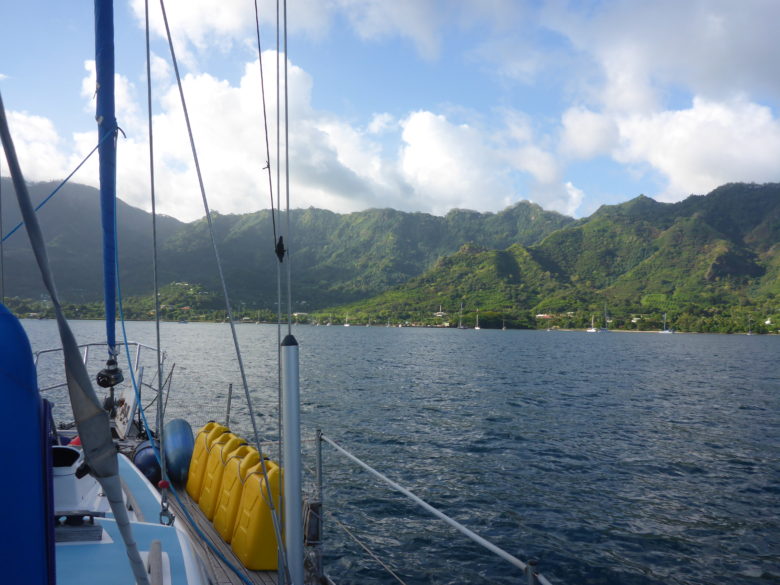Some South Pacific Islands
08:54.97S 140:05.98W 17th July 2016 Baie de Taiohae, Nuku Hiva
Rob counted six magical temporary waterfalls cascading down from the Plateau atop this island after the deluge we had earlier, all clearly visible from Zoonie. It has turned the water around us into red/brown muddy streaks. We won’t be making water today!
“Where’s the tripping line buoy babe?”
“Oh I saw it floating along the hull a few minutes ago, it’s probably wrapped itself around the chain as we turned.”
Hmm. I recalled losing the oars overboard from our tender left tied alongside the Elizabethan 29, Berenice, I used to crew in from Blyth to Lindisfarne (Holy Island) in Northumberland. An unexpected gale blew up in the night and we weren’t about to rescue the inflatable dinghy that was spinning round on its painter. It wasn’t going anywhere unlike the oars.
The next morning we wandered around the shoreline and found both oars parked up on the beach of a nearby bay. I envisaged us doing the same tomorrow in search of our bonny little red buoy.
I awoke from a snooze to the happy news that the little red buoy is back in place bobbing around.
Our anchorage is in a caldera and the entrance, where the water must have rushed in millions of years ago as the caldera rim gave way, is marked by two, fine and inviting rocks, The East and West Sentinels and even more enticing is the natural white crystalline cross in the land mass to the right.
Ahead, as we motored at around 3 knots just to take in the aura of the place, are the high emerald green folds of the original volcanic rim. Softened by erosion, bringing many slopes to 45’ from the vertical, the human habitation is along the shore and spasmodically into the hills, reminding me of the coastal settlements in Santa Maria on the Azores but without the ascending vine terraces.
What interest lies ahead? And why are all the flags at half-mast? “Maybe because it is Bastille Day,” said Rob.
In this Bay in 1842 Herman Melville and his friend, Toby Greene, jumped the Massachusetts whaling ship, Acushnet, as he found the life tedious and the whales were fished out in this area even then. He is now recognised by some as America’s finest 19th century writer with such titles as Typee, (the name of the tribe he lived with and who cared for him on the island) and Moby Dick.
We ‘jumped ship’ to the concrete quay and found a local market full with fresh vegetables and fruit and wandered up the concrete road to the Gendarmerie to clear in. A charming, rotund, blue eyed Frenchman was happy to go through the formalities even on a Saturday.
“Your occupation, retired, ah very nice, that’s me in two years.”
“Will you go back to France to live?”
“Oh no, not with Europe as it is, financial, security, why would I want to do that?”
Back down near the little quay, in the new information centre we found a lovely French lady who was more than happy to practice her English on us. She mentioned that the weekends in July are when local village traditional Polynesian dance groups compete with eachother in Saturday night dance competitions which are well worth watching.
We came away with plenty to read and a booking with Eric on Tuesday for a day long guided tour up into the valleys and Toorii Plateau. “Take your hiking boots and some shoes to wear when you go swimming,” she said, “and be here for 8.30 am.”
Because of the daytime temperatures here a lot of the work is done early in the morning, the bakery, for example is open 4.00am to 6.00am and the supermarket, which opens at 5.30am, is only likely to have any bread until around 10.00am. So I am experimenting with making some on board. The sourdough mix I have underway at the moment is not rising, I guess the yeast in it might be too old, but if all else fails I will roll it very thin and make pizzas.
I still have a store of dried yeast in packets so I may have more luck with that.
From the writings of other cruisers we knew that Chez Henry’s shack on the quay provided a delicious dish called Poisson Cru made of raw fish marinated in Lime juice and served in coconut milk with boiled rice. It was really good and plenty of it. Rob had a chicken stir fry and we sipped pamplemousse juice through a straw (A cross between an orange and a grapefruit and tastier than either) while we ate, sitting under a fabric roof with a local dog fast asleep on our feet.
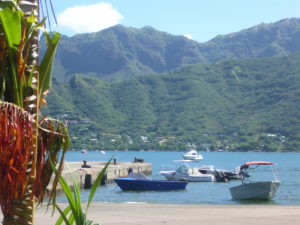
Busying ourselves on Henry’s excellent Wi-Fi, while he and his mate hacked a dead cow into bite size pieces amidst a swarm of flies, we learned why the flags are at half mast, and why the Gendarme was scathing of the prospect of returning to Europe, and felt for the victims and families in the beautiful town of Nice, the latest to be ravaged by a psychopath.
I also discovered an article I wrote last year has been published by Practical Boat Owner in the August edition and they needed somewhere to send the cheque!
As we lay in bed a couple of nights ago we pondered how to safely clean the hull in this bay which, is also the home of a healthy black tipped shark population. A brown/orange algae growth had spotted her hull stem to stern and barnacles and long necked goose barnacles covered her waterline to a depth of about 12 inches. Not only did this look unsightly but it slowed us down by nearly one whole knot!
It seemed important to have a running line along the hull to which we could attach the bow and stern line of the dinghy, so a rapid escape from ‘Jaws’ should he raise his ugly head, back on to Zoonie could be done knowing the dinghy was not going to float away.
Fortunately the local marine residents were otherwise occupied and we took about two hours to scrape each side with Rob doing the donkey work and me holding the dinghy in a working position for him, or trying to anyway.
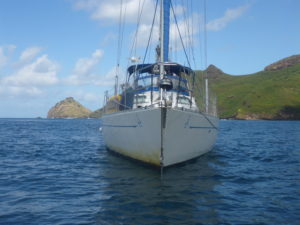
After our mornings exertions we were hungry for a little historical culture so it was off to the Danse Marquesienne after the baking sun had thankfully sunk beyond the hills.
For all of £2 each we had second row seats with two little children infront of us and a fine view of the dance floor. All around and overhead was decorated with fresh, lush green foliage in this very modern barn type hall. Islanders of all ages started arriving, some wearing garlands around their heads and dressed to the nines. A little boy in his baby grow beat out a very presentable rhythm on one of the drums while waiting for the evening to start.
A charming, gay compere spoke through a mike to keep us aware of the progress towards the start. (homo sexuality is looked on as the third gender in non-European areas) There were a few other yachties like us but most seemed to be locals. This was not being laid on for tourism, but a part of the ongoing value the islanders place on their culture and past.
The judges were all in place behind the table on one side and as an expectant hush descended the big double brown doors opened and male dancers led the procession with more long poles decorated at each end with pairs of round green breadfruit and big green leaves in the middle. They laid these on the sides of their entranceway and filed around the dance floor until it was full with men and women aged from teen years to middle age and in fabulous attire of grass skirts, bands of grass tied around their legs and arms, headdresses of feathers, tattoos, bead skirts, war paint on the warriors’ faces. What a spectacle.
A choir of women and men on drums had no volume control and belted out the rhythmic chanting as a young lad lit all the grass torches that skirted around the central floor before the dancing started.
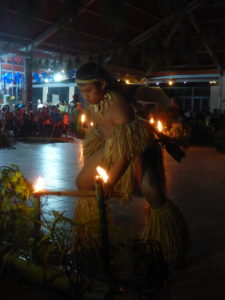
The children in the audience were all eyes, wondering when they would be able to take part maybe.
There followed and hour of vocal and dance narratives of their lives, domestic activities with the women sitting cross legged on the floor, hands and arms weaving their story around them, their long black hair waving from side to side, battles with the well-built men mock fighting amidst loud singing and drumming.
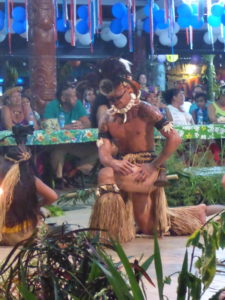
“What on earth is that,” said Rob “A child or a pig?” An ear-piercing squeal rent the air above all other sounds.
It was a pig! A boar like piggy with big black spots, pulled unceremoniously around the floor as it was ‘stolen’ from its owner by a hog rustler from another tribe. It was hidden in a corner of the floor in a little pen where it tucked into some goodies while the dance continued. Then the real owner came to collect it, amidst mores indignant squeals, as it was carried out having finished its performance.
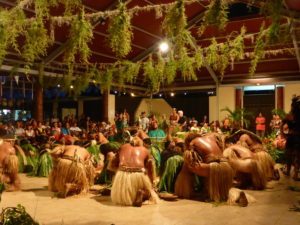
As the evening wore on many children fell asleep on loving laps despite the noise, no need for baby sitters in this society.
Towards the end of the evening three beautiful young girls with slim figures, straight flat backs and tiny waists came dancing on their tip toes across the floor. They wore skirts made of silver beads strings that caught the light, rows of upright black and white feathers in a band around their waists and more feathers as headdresses around their foreheads.
They tip toed with many tiny steps around the floor and then stood on green leaf mats infront of the judges weaving their hands and arms as they made their bodies vibrate like belly dancers. Quite lovely. We were so glad we didn’t miss this gift of an evening.
The sourdough pizzas were tasty and I will turn the rest of the dough into tortillas tomorrow, waste not want not. But it’s ashore by 7.30am tomorrow (reckon?) for fresh bread and a local sim card for my old Blackberry so we can communicate with home.
Well we made it ashore early and came to tie up by where the fishermen were preparing their catch for sale. The water alongside us thrashed with hungry sharks every time fish scraps were thrown in, so we very, very carefully climbed the stainless steel ladder to the quay!! There was plenty of lovely French bread, baguettes and pastries at the supermarket. A new mobile phone with a local sim card is now ready for use so we can contact family for a chat.
22nd July Friday. End of a dynasty and a concrete signature.
On Tuesday we went on a day long tour with Eric in his Dacia 4×4. During the night right up until we went ashore it had rained hard and violent gusts of wind repeatedly fell from the mountains onto the waters of the bay. But for the tour we had fine weather as we ascended the steep valley towards Taipivai.
Eric came from Grenoble 15 years ago having planned and saved for his exit from his home country for many years before. He is here for two more years when he will move to Tahiti with his 13 year old daughter so she can complete her secondary education there.
We ploughed through deep fords and wound our way around the recent avalanches of mud and rocks, past groups of wild horses and luxuriant undergrowth.
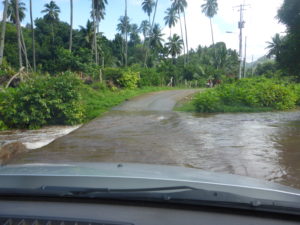
Ragged basalt ridges laced the uprisings of the long extinct volcano and we pulled in to the first of many stops. Eric mentioned Herman Melville and how his fame had grown on the basis of not only his literary talent and the subject of his book being a local tribe but also on the fact his stay was for a mere month at the most.
He also talked of the strange case of the German couple aboard their catamaran who anchored in Hakaui bay a few years ago.
The man apparently went off hunting with a local and disappeared. Police descended from Tahiti and eventually found his charred bones in a fire. It was all a bit of a mystery but the local was apparently charged and is now in prison, the girlfriend returned to Germany and wrote a book about the events and the family came and retrieved the boat.
We continued upwards and came upon some new road laying. “There is a machine that grinds the rock to make the gravel and sand so all we have to import is the cement,” Eric commented as a masked and white-overalled road worker tipped a bag of cement into the mixer in a cloud of white dust.
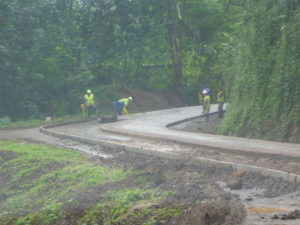
The industry on the island is dependent on fruit. Coconuts are cut in half at small roadside ‘factories’ the white flesh is extracted and dried, sometimes over fires, before being sent to Tahiti. It is called copra and is then pressed and the resultant oil has many uses.
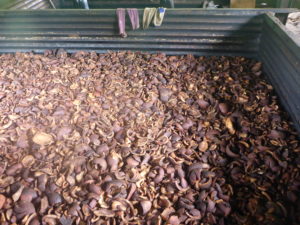
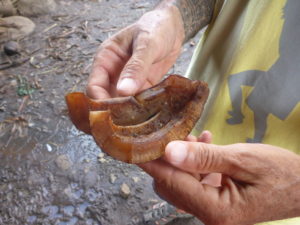
A grey/white fruit called Noni is harvested and fermented before being sent to Tahiti from where it is then shipped to the Morinda juice factory in Salt Lake City, Utah where the Mormons make it into a fruit health drink. Although other localities now produce the fruit on a more commercial basis, the Mormons remain loyal to these islands and still buy the raw product.
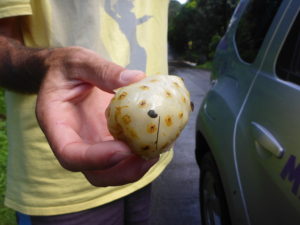
It reminded me of the pre agricultural revolution days in the valleys of Cornwall that used to be heavily populated and busy with agricultural processes. Not so long ago there were 60,000 to 70,000 people in French Polynesia but diseases from Europe drastically reduced the population so that a century ago the ancient cultural and religious traditions of this area were almost lost. It is thanks largely to the interest of a few Europeans and Americans that there is now a healthy revival in the population and culture.
85% of the people are seriously Roman Catholic but this does not prevent them from valuing their past history and all it contains.
Over the ridge and we are descending down the concrete road with fine views of the bays on the north shore of the island, to a fully restored tribal habitation site at Hatiheu set beneath a giant Banyan tree. The last reigning monarch here was a queen, her great grand-daughter, Yvonne, owns and runs the restaurant where we would have lunch in the bay a little further down the road, so I guess she is a princess.
The site has an open paved area (Tohua) where 5000 people still gather at festival times. The typical homes are highly pitched roofed shelters built on two levels of laid rocks, (paepae). The lower level is outside, for daytime activities like cooking. There is a large hole to one side in which fermented bread fruit could be stored for a few years for eating. At the back of the roofed shelter is a sunken area that was filled with soft foliage in which the people laid alongside eachother to sleep.
The more sacred areas are up hill from the human activities, rock platforms where the dead were laid out and oiled, then their bones may be taken into the home or hidden inside the aerial roots of the Banyan Tree. At the back of this arboreal monster was a hole, 10 feet diameter and 14 feet deep where prisoners from the latest tribal clash were held awaiting the pot!
Near the tree, on large rocks, Petroglyphs of men, fish, turtles etc tell of their history and are still deemed as sacred.
We continued along a dirt track to Baie d’Hatiheu, the favourite island location of Robert Louis Stevenson. When the locals were suffering from diseases and seeing their relatives and friends dying the local priest told them that if they erected a statue to the Virgin Mary at the top of the nearest basalt ridge then the disease would finish and it appears it did. That must have reinforced their faith in the new monotheistic God!
Meeting Yvonne we felt in the presence of someone special, this petite lady with dyed black hair and an inch of white roots lost her husband when they were young and has no children – the end of a dynasty. Eric did not hold out much hope for the future of her restaurant with her present partners, but who knows.
The food was good, Rob had goat, Eric had pork and I had fish. We were the only customers in this big restaurant, but every three weeks the local supply ship sends around 100 visitors along for a meal and with the population of 4x4s on the island I have no doubt they are busy at weekends.
Next to the restaurant and beside the old primary school (the new one has been built further up the hill to keep the children safe in case of a tsunami) is Yvonne’s museum full with ancient artefacts, stone machetes, spears, head crushers, headdresses and grass skirts, stone anchors and pictures of natives covered in tattoos, amazing.
On our way back we came upon the road works once more. Work had finished for the day. But there was no cordon to keep traffic on the hard concrete side of the road and off the fresh, virgin, tenderly smoothed cement. Not sure whether it was my hushed “No”, or Rob’s “Oops” or the shlushing sound of the fresh cement under the tyres that alerted Eric to his error but there is now permanent evidence of our passing left in the new road!
Our New Zealand friends Jane and Paul, had told us that when they arrived here a few months before us there were 60 – 70 yachts in the bay. This was because there was a 90% chance of a hurricane warning in the Tahiti area so they all evacuated here, out of the area. Then there was no hurricane, but the threat of course is very real. At present there are around 30 yachts which is more typical.
We need to refuel and so are waiting for our tax exempt certificate, then we have the choice of backing up to the concrete quay, having anchored the front end of Zoonie off first, or anchoring in the vicinity and transferring the fuel in jerry cans. I think we might end up doing the latter.
A couple of days ago we had just the rear underneath of Zoonie’s hull left to clean. In the fresh light of the morning Rob went into the water and I sat on the transom, boathook in hand, ready to poke out the eye of any black tipped reef shark that might come Rob’s way for a nosey around.
After that it was ashore to find the internet was down island wide so instead of getting in touch we set off to explore the far end of the bay.
There is an area by the shore just like the habitation I described earlier, but this one, on our doorstep, was where the first island contact was made with visiting Europeans. They must have been tense times, meeting what would have looked like warlike warriors, covered in tattoos, wielding beautifully carved clubs and sling shots.
We found Rose Corser’s small restaurant/hotel (8 rooms) and museum and took a seat on the veranda overlooking the bay. Rose is an inspiring, elderly Californian Professor of Art and Cultural history who has always been interested in the history of this island.
Forty years ago she sailed here with her husband and they started their first hotel. We were privileged to talk with her, firstly in French before she realised we were English, but she left us in the little museum, with the de-humidifier running, while she went to welcome her latest European group of guests.
The contribution she has made to the perpetuation of the ancient way of life here is immeasurable. We bought from her a fine Tiki (human faced representation of one of the old gods) in rosewood, carved by a local craftsmen and carefully selected by her for the contrast between the light and dark grain. Tiki has become our lucky mascot and is attached to the mast by the dining table.
Last night here was typical. It rains a lot in July and with it comes wind and swell which sets us all rolling and makes sleeping a spasmodic affair. However the night before was clear, with a full moon casting its silvery light all over the bay, a bright satellite sped across the sky and what can only have been the International Space Station rose after the moon in a bright blue and red light.
During the day flesh footed booby birds compete with the frigate birds and sharks for their fish.
First to report is a cracked computer screen, after an abortive attempt to send some photos to Yachting Monthly for an article, our casting the dinghy off to return to Zoonie was problematic and in the process the computer, in the padded water-proof bag, must have knocked something and now I write this within two black lines running from the bottom corners to the screen to a black blob in the centre top.
Fingers crossed everything is working on the computer and let’s hope it lasts until New Zealand, when we were planning to get a new computer anyway because the old Dell Finally screamed to a whiteout death two thirds of the way through Mama Mia and now will not even take a charge.
Last Dance in Nuku Hiva
On our last afternoon in Nuku Hiva we took the lengthy and laborious option of taking the 4, 20 litre diesel cans across to the Total fuel station in the dinghy, climbed the stainless steel ladder, amidst children fishing for crabs and a kindly Frenchman who, carrying my full can for me called to the garage attendant in a well-meaning way to say what are you letting this beautiful young woman do this for eh? Well I can imagine can’t I.
On our third trip a blue footed booby bird stood watching the proceedings with his cute pale blue green feet hanging over the rubber fender he was standing on. Mostly dark brown plumage, but he wore a pristine white waist coat with a chic straight cut from shoulder to shoulder. In flight they look like small gannets and the head and beak are similar too.
He made the trips worthwhile. We did three, carting 240 litres to the boat and on the first can of the last trip we were full so we didn’t have to go back again and all the cans are full too. So that’s what we used to cross the Pacific, 120 hours, about 500 miles as much of the time the engine was only charging the batteries and not propelling the hull.
On Saturday evening we dodged the downpours to enjoy the Tahitian Dancing at the same venue as before.
In the scent of thousand times crushed blossoms the dancers spun, dived, reached and chanted at full volume for short bursts of time and then stopped, lapping up the applause before starting again on a different theme. They wore only flowers and foliage, no feathers this time. It was different from the local dances and just as exciting.
Sometimes nature’s raining percussion was so hard on the metal roof it threatened to outdo the drums inside. Mists of rain reached in to the dance floor through the glassless windows as if it wanted to join in and dancers slipped on the wet floor.
It was persisting when we all left and Rob and I sheltered with the other returning yachties under Henry’s canopy before we ran the gauntlet back to our dry, lit home.
Strong gusts of wind fall off the caldera rim over the bay, but mercifully they are short-lived so although Zoonie straightens her anchor chain slightly as the wind pushes her away from it the gust doesn’t last long enough to pull on the anchor itself.
The next morning the bay echoed to rhythmic drumming practice and canoes were out and around for exercise, and this was on their Sunday. We decided to cross the 82 miles to Hiva Oa overnight so we left at 11.45 pm. and arrived 23 hours later after a lovely sail 60 degrees off the wind and with a tide pushing against us at about 1 knot.
At 3.20am in the moonlight we could not miss the monolith of Hiva Oa, every lungfull of breath smelling of flowers.
